Cultures > Assyria > Middle Assyrian Kingdom
Middle Assyrian Kingdom
Background
The Assyrian Middle Kingdom was born out of the collapse of the Old Assyrian Kingdom during the Bronze Age Collapse and saw the second resurgnce of the Assyrian power in the region. While Adasi and his weak successors were struggling to maintain power in the anarchic city of Ashur, a great power known as the Kingdom of Mitanni was growing in the eastern area of Anatolia (Asia Minor) and was threatening to disrupt the stability of Mesopotamia with its expansion.

Egypt & Mesopotamia Map (1450 BC) - Historical Atlas (1923)
Assyria soon fell under the control of Mitanni until the Hittites invaded under king Suppiluliuma I and replaced the Mitanni king with their own. During this period of external forces fighting within the city of Ashur the Assyrians were able to mount an offense and waited for an opportunity to strike. Rule was passed down through descendants, with the first king of the Middle Kingdom being Eriba-Adad I (1380–1353 BC). Rule was then passed down to his son Ashur-Uballit I who was able to fight back against foreign rule over Assyria.
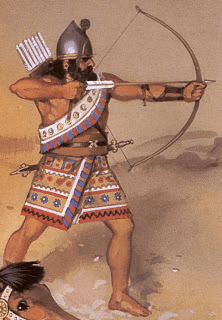
Assyrian Archer Drawing
When the time seemed right the Assyrians struck back and pushed the Hittite invaders from their city and reasserted control over the city of Ashur and its territories. The Hittites tried to reinvade and take the city but under the leadership of Ashur-Uballit I (1353–1318 BC) the Assyrians were able to push back the combined Mitanni and Hittite forces and reclaim Assyrian dominance in the Mesopotamia region.
Bronze Age Collapse
It appears that Assyria stagnated for several hundred years until around 1,300 BC when it was able to reassert itself as a regional power. It was during this time that the Bronze Age Collapse occurred and saw the destruction of nearly all Mycanaean Greece and the collapse of Egypt so the fact that Assyria merely stagnated instead of totally collapsed is pretty impressive. This is the era of Homer and the Iliad and the Trojan War.
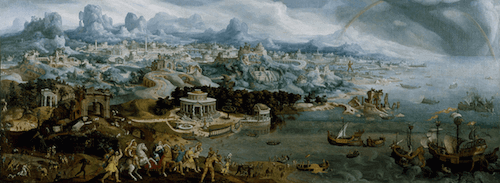
Abduction of Helen - Maarten Heemskerck
Assyria was most likely able to buffer itself from most of the destruction by being more geographically isolated than the rest of the eastern Mediterranean area known as Asia Minor or Anatolia. The Bronze Age Collapse was worse than the collapse of the Roman Empire so that should give you a sense of how catastrophic this event was for the progression of civilization.
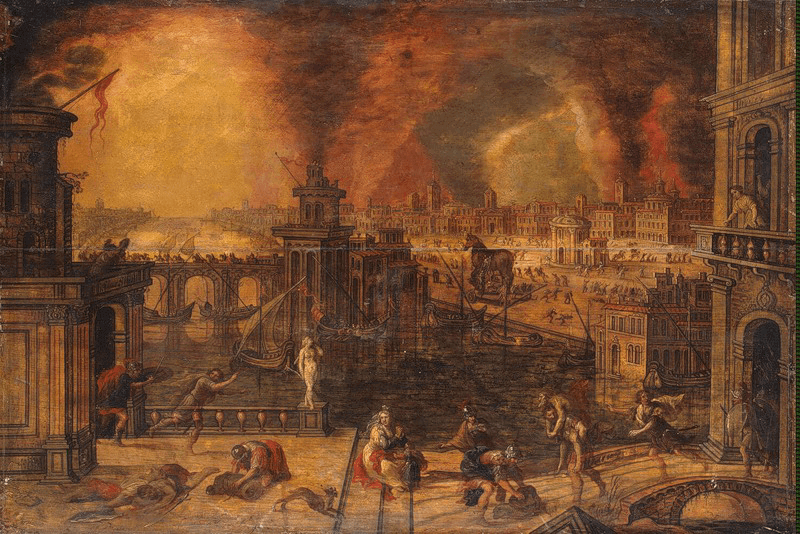
Fall of Troy - (17th Century)
This is unusual because it appears that both Greece and the Eastern Mediterranean along with Egypt and Asia Minor experienced about 400 years of dark ages and a complete collapse of society after a period of brutal warfare and extreme destruction. The only thing separating the eastern Mediterranean and Assyria was the expansive Arabian desert which most likely made Egypt the prime target instead of Assyria for invading forces. However, around 1300 BC Assyria was conquered a few times most likely from the impacts of the Bronze Age Collapse on other civilizations in the region and in the ensuing chaos Assyria was able to reassert dominance in the region and establish the Middle Kingdom.
Adad Nirari I
Rule over Assyria was passed down to Ashur-Uballit's son Enlil-nirari (1317–1308 BC) and his son after him Arik-den-ili (1307–1296 BC). These two rulers appeared to have maintained the territory gained by Ashur-Uballit but were unable to expand the empire. The next king that would expand the borders of Assyria would be Adad Nirari I (1295–1264 BC) who was actually able to drive the Hittites from their major cities and gained great amounts of territory to the north and south of Ashur.
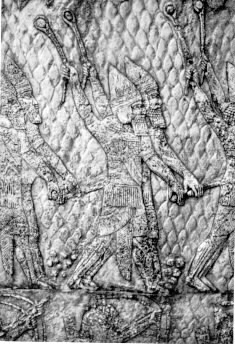
Assyrian Warriors with Slings Engraving
In fact, king Adad Nirari I is the king we first really known about because of the abundance of written inscriptions in the historical record. It appears he left many inscriptions behind of his achievements and many of them have survived along with personal correspondence between the Assyrian court and the Hittites. These inscriptions and letters prove that no regional power took Ashur seriously until it was able to assert itself in the region and become too powerful to control. This appears to be a common theme in ancient civilization.
After conquering the Mitanni and the Hittites the Assyrians began relocating them from their conquered territories. This was far from inhumane however, king Nirari I had decided that the best way to prevent future conflicts and uprisings was to simply remove the people from the area. Researchers note that this was a peaceful and organized transition. The refugees were able to reach their final destination healthy and with abundant food and supplies. All of the deportation murals depicted show women and children traveling in vehicles or riding on animals and no one appears bonded or chained. There is no reason to accept this as anything other than true given the graphic violence displayed on other murals and art.
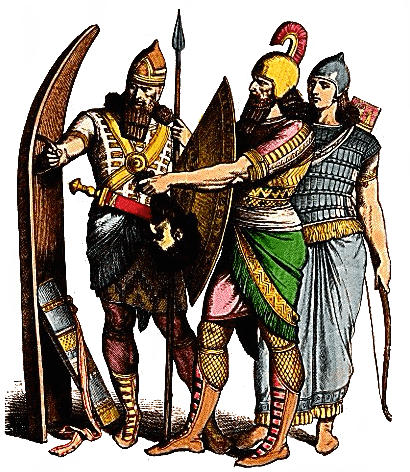
Assyrian Soldiers & Archer - History of Costume (1880)
It also appears no families were separated and not everyone was chosen for deportation. Most of the deportees were sent to different territories of the kingdom where they could work but be watched. While populations that actively resisted the Assyrian government were either killed or enslaved, this was not the norm. In fact most of the populations of the conquered territories simply assimilated into Assyrian culture and began to consider themselves Assyrians.
The reign under king Nirari was marked by stability and prosperity in Assyria. He was able to engage in massive canal and irrigation projects along with restoring temples, roads and city walls. The foundation that Nirari was building would prove to be a great foundation for the Neo-Assyrian Empire. Nirari was able to organize massive groups of people to work on these projects due to the stability of the newly expanded Assyria. Without any internal or external threats Nirari was able to organize massive operations with ease. It was during this time that the city of Kalakh was established during this period around 1274 BC.
Shalmaneser I
King Nirari's successors would ultimately continue and even expand his policies of relocation and conquest. When he died, his successor named Shalmaneser I (1263–1234 BC) continued to expand Assyrian Empire. Under the leadership Shalmaneser I the civilization of Assyria overtook and conquered the entire Mitanni civilization and assimilated its culture. His later descendants would continue the tradition of military expansion.
Tukulti-Ninurta I
Tukulti-Ninurta I (1233–1197 BC) who ruled after Shalmeneser was a brutal warrior ruler who vowed to expand Assyrian borders and maintain internal security at all costs. According to ancient inscriptions he put down revolts and maintaining his control at all costs. However, he was very careful to appreciate a conquered civilizations culture and knowledge, often sending the scholars and intellectuals to be relocated. Scribes and scholars were often sent to the capital at Ashur in order to catalogue all of the written works of the empire.
Tukulti-Ninurta was one of the most literate of the Assyrian kings and he greatly documented his victory over the Kassite dynasty in Babylonia and also of his conquest over the Elamites. Tukulti-Ninurta was also successful in beating the Hittites Hittites at the Battle of Nihriya (1245 BC) which was the turning point for the collapse of the Hittite civilization.
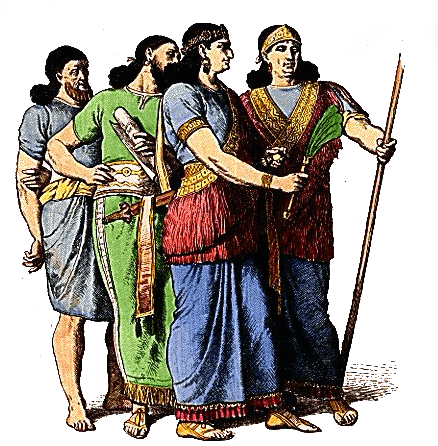
Assyrian Commoners, Court Official & Nobleman - History of Costume (1880)
After severely sacking the city of Babylon, he plundered its temples and forcefully relocated the king and much of the population back to Ashur as slaves. Using this newly gained wealth he built a grand palace at Ashur, despite the public opinion turning against him for his destruction of Babylon. Much like the later king Sennacherib, the destruction of Babylon was seen as a religious offense as Assyrians and Babylonians shared much of the same religious aspects. Due to this action one of his sons named Ashur-nadin-apli (1196–1194 BC) saw him assassinated and took his place on the throne. This was most likely supported by many of the court and religious officials as well.
Ashur-nadin-apli passed on rule to his son Ashur-nirari III (1193–1188 BC), who in turn passed rule onto his son Enlil-kudurri-usur (1187–1183 BC). Rule was then taken by a descendant of an earlier Assyrian king named Ninurta-apal-Ekur (1182–1180 BC) and this is where the dates start to get a little foggy. It appears after this conquest of the throne by Ninurta-apal-Ekur he is overthrown by the son of Ashur-nadin-apli named Ashur-Dan I (1179–1133 BC). His son Ninurta-tukulti-Ashur (1133 BC) ruled after him briefly, before his rule was contested by his brother Mutakkil-nusku (1133 BC) who appears to have held the throne for a short while then died. The son of Mutakkil-nusku named Ashur-resh-ishi I (1133–1115 BC) assumed the throne after his father and was able to begin to stabilize Assyrian rule.
Tiglath-Pileser I
The period of stasis ended when the next Assyrian king known as Tiglath Pileser I (1115-1076 BC) ascended to the throne. He was the son of Ashur-resh-ishi I and engaged in a new series of massive military campaigns that would shape the Assyrian borders for future generations to follow. He also was well known for commissioning public works projects and building up cities and walls. This was a tradition and precedent that future Assyrian leaders would continue to follow and would bleed into Babylonian culture as well.
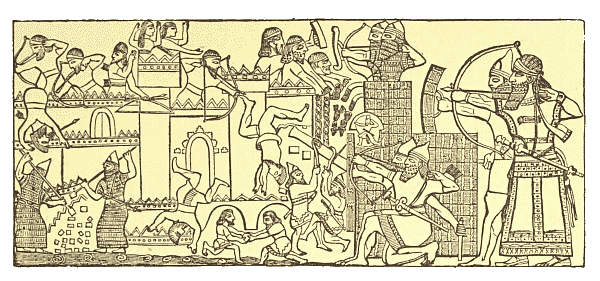
Assyrian Siege of a City Relief
Tiglath acquired vast territory throughout Anatolia (Asia Minor) that extended all the way to the Mediterranean Sea. With Ashur still being the capital of the empire, Tiglath initiated the building of a grand new palace along with a massive library that would store the cultural accumulation of all of Assyria. This could not actually have been to hard as it is known that nearly all of the cities along the eastern Mediterranean were nearly decimated and this damage extended far into Greece and Egypt as well. Not everyone was killed so it makes sense that Assyria may have acquired many of the skilled and general workers from these collapsing civilizations.
Remember in the context of the ancient world, the Bronze Age collapse was orders of magnitude bigger in impact and scope than the collapse of the Roman Empire. During this entire turbulent period the Assyrian empire remained relatively stable which meant it was an ideal target for refugees fleeing the Armageddon imposed upon them.
Great Library
Tiglath was a known avid collector of cuneiform tablets, which were still written in the Sumerian script even at this point in history which is interesting to note. This library held works on all sorts of subjects and Tiglath also started commissioning the first royal histories. In fact, the library created at Ashur would serve as the model for the larger library created at Nineveh by future king Ashurbanipal known as the Library of Ashurbanipal.
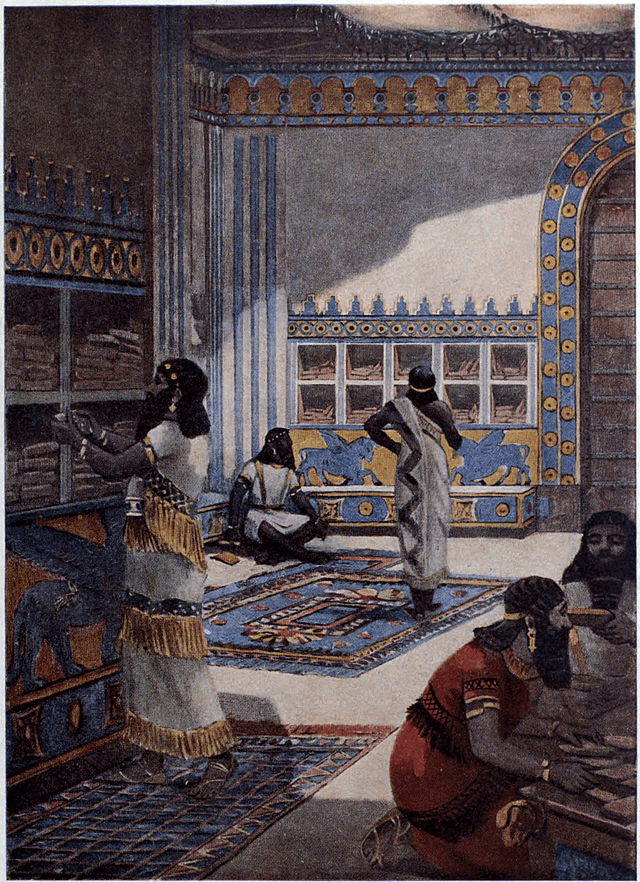
Library of Ashurbanipal - Story of the Nations Hutchinsons
It is important to note for Hanging Gardens researchers that Tiglath was one of the first people to begin construction of commissioned gardens and parks that were built with both foreign and domestic flora and fauna. This tradition would continue to be built throughout all Assyrian towns so it is highly likely that a grand structure like this existed at Babylon as well in the future (Leick, 2000).
Through his efforts of military conquest and the acquiring of new specialized workers along with additional resources Tiglath was able to revitalize the economy of Assyria and the empire entered into a Golden Age. Under this Golden Age arts and intellectual pursuits flourished and the precedents set during this time period such as the cultivation of knowledge through the building of libraries is an important characteristic to note for all future civilizations.
Period of Decline
When Tiglath died his son Asharid-apal-ekur (1076–1074 BC) ascended to the throne and ruled for two years without interruption. He was succeeded by his brother Ashur-bel-Kala (1074–1056 BC) who was the king until his rule was challenged and Assyria was plunged into a period of civil war. The rebellion was quickly crushed and the instigators executed, however in the wake of the chaos many city-states had chosen to exercise their independence and broke away from the Assyrian grasp.

Assyrians Suing for Peace Relief
The first to do was an area known as Eber Nari and includes the territory of modern day Syria, Lebanon and Israel. This territory was important for the Assyrian Empire because it was their only access to sea ports of the Mediterranean. After exercising their own sovereignty, the Aramaeans now began invading and claiming Assyrian territory as their own.

Palace of Ashurnasirpal Drawing
The successor to Ashur-bel-Kala was his son Eriba-Adad II (1056–1054 BC) who ruled for two years before being ousted by Shamshi-Adad IV (1054–1050 BC) who was another son of Tiglath I. Following his rule his son named Ashur-nasir-pal I (1050–1031 BC) succeeded him and eventually his son Shalmaneser II (1031–1019 BC) succeeded him. While all this was going on, the Amorites of Babylonia and Mari also broke away from the Assyrian Empire and were able to exercise a slight sphere of influence. It is clear with all the internal conflict that the Assyrian Empire was ripe for independent revolutions to spring up throughout the region.

Monolith of Shalmaneser II Tablet
Rule was passed from Shalmaneser II to his son Ashur-nirari IV (1019–1013 BC) who then passed the rule on down to his son Ashur-rabi II (1013–972 BC). Ashur-rabi II passed the rule down to his son Ashur-resh-ishi II (972–967 BC) and eventually to his son Tiglath-Pileser II (967–935 BC). Tiglath II was eventually replaced by his son Ashur-Dan II (935–912 BC). The Assyrian Empire shrank rapidly through this period and experienced many rebellions from within as well that disrupted trade and threw the empire into chaos. There was nothing Assyria could do without a strong king so it persisted in a diminished capacity for several years.
Neo-Assyrian Empire
Assyrian King List
